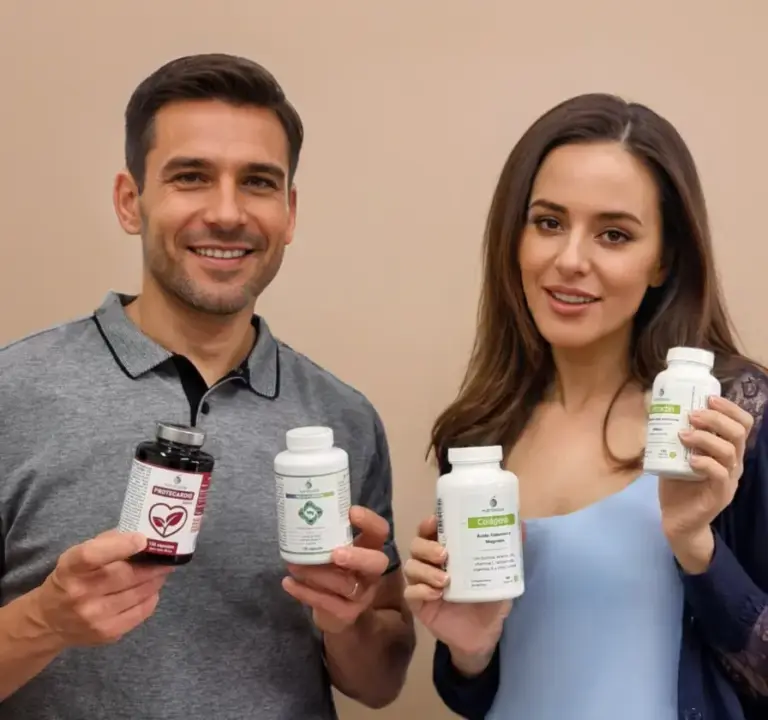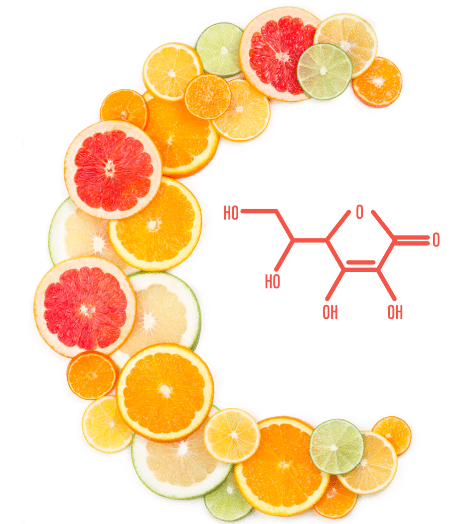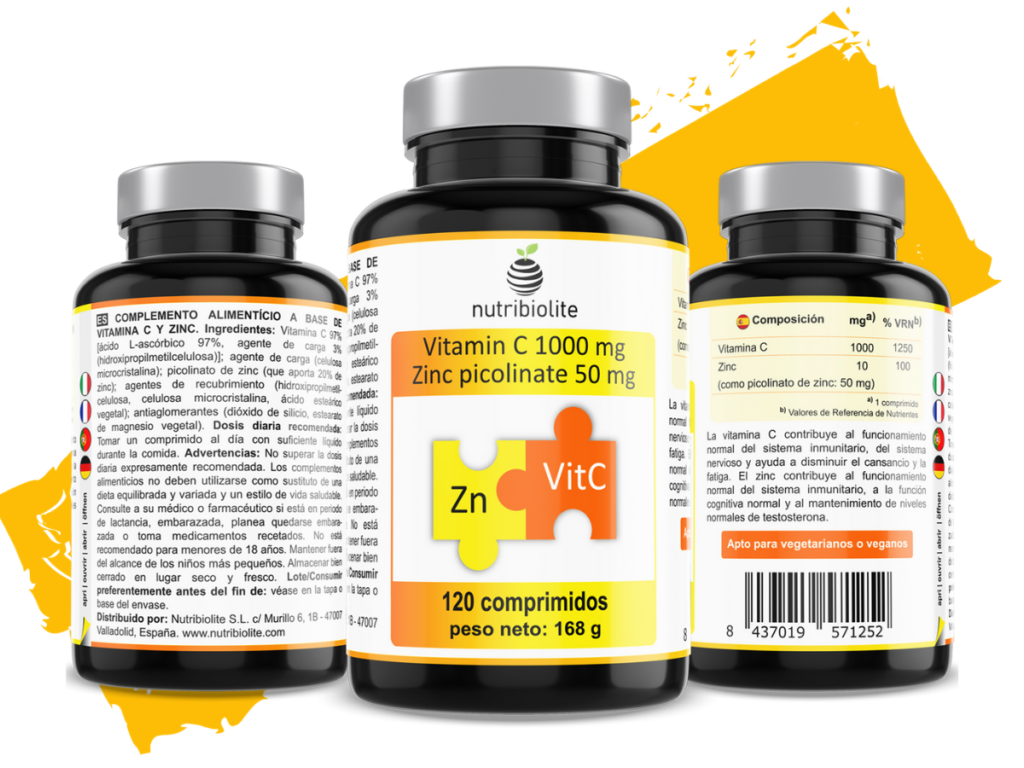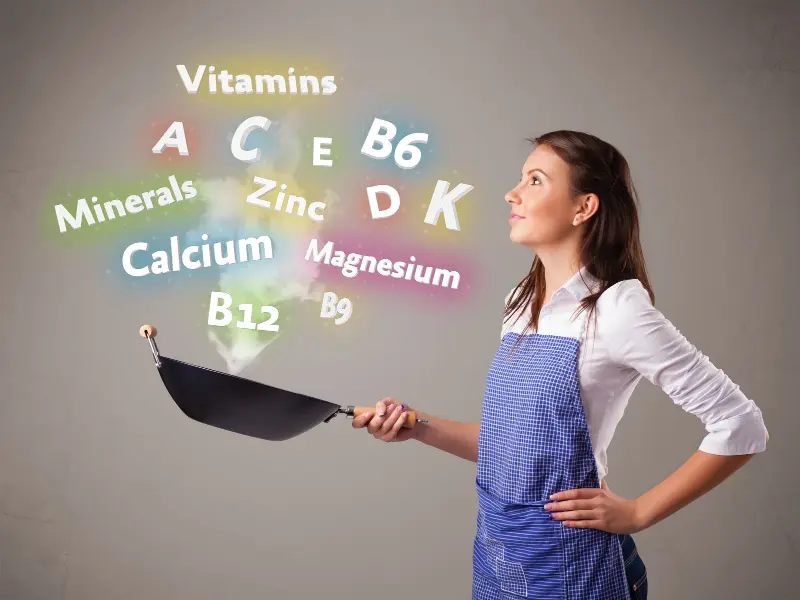In the complex network of biological factors that regulate human health, vitamin C and zinc play an essential role in strengthening our natural defenses.
Vitamin C: an essential nutrient
Vitamin C, or L-ascorbic acid, is a micronutrient that plays a fundamental role in maintaining our health and well-being. For us, human beings, this vitamin is an essential nutrient, since our body is not able to produce it, lacking an enzyme called gulonolactone oxidase, capable of catalyzing the conversion of glucose to vitamin C. Moreover, since it is a water-soluble vitamin (water-soluble and fat-insoluble), it is unable to be stored in our body, so we must obtain it regularly through our diet.
Vitamin C is the main non-enzymatic water-soluble antioxidant present in blood plasma, where it is found predominantly in the form of ascorbate anion and to a lesser extent, as ascorbyl radical and dehydroascorbate anion. The latter two molecules are generated by two consecutive reversible oxidations of the ascorbate anion.
The main characteristic of vitamin C lies in its ability to donate electrons to other molecules, which gives vitamin C its function as an antioxidant agent and as an enzymatic cofactor, both associated with its benefit to our natural defenses.
Antioxidant function
Vitamin C is a highly effective antioxidant, thus protecting important biomolecules (proteins, lipids, carbohydrates and nucleic acids) against damage caused by free radicals, by oxidants generated during normal cellular metabolism or by exposure to toxins and pollutants 1, 2. By counteracting the action of free radicals and oxidizing agents, vitamin C helps maintain the integrity of cells and tissues, protecting organs and skin against the aging process and diseases such as atherosclerosis (through oxidation of low-density lipoproteins), type 2 diabetes (through oxidative stress on the beta cell) and cancer (through the DNA repair mechanism and oxidative-related DNA damage)2.
Enzyme cofactor and epithelial tissue integrity
Vitamin C acts as an enzymatic cofactor in numerous reactions such as lysine/proline hydroxylation, carnitine biosynthesis, neurotransmitter and hormone biosynthesis, and tyrosine metabolism. Of all these enzymatic reactions, the best studied is the hydroxylation of proline to form the hydroxyproline necessary for the synthesis of collagen, the most important protein in connective tissues (cartilage, bone matrix, ligaments, skin, tendons, veins, arteries, etc.).

The presence of collagen in the skin, joints and blood vessels allows the correct functioning of these structures, as well as their proper healing in case of injury, being essential to maintain and strengthen our natural defenses.
Vitamin C and natural defenses
According to several studies, vitamin C could have an effect on our natural defenses, as it seems to influence both cellular (functioning of defense cells) and humoral (production of antibodies by B lymphocytes) immune responses.
For example, in vitro studies have confirmed that vitamin C stimulates both the production 3-7 and function 8, 9 of leukocytes, especially neutrophils, lymphocytes and phagocytes. These defense cells accumulate vitamin C in high concentrations, which may protect them from oxidative damage 10-12. It has been observed that these cells are capable of storing 50 to 100 times more vitamin C than that present in the bloodstream 13.
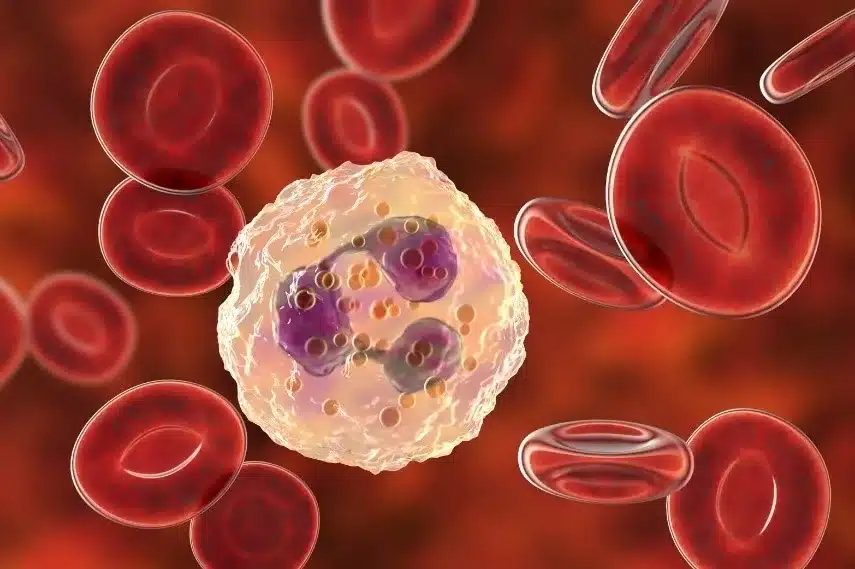
13 In fact, it is crucial that leukocytes contain high levels of vitamin C. When confronted with invading microorganisms, phagocytic leukocytes release non-specific toxins such as superoxide radicals, hypochlorous acid and peroxynitrite. Although these reactive oxygen species (ROS) play a key role in the elimination of pathogens, they can also cause damage to the leukocytes themselves during this process. Vitamin C, through its antioxidant properties, has been shown to play an essential role in protecting leukocytes against self-inflicted oxidative damage 12.
By virtue of these benefits, EU Regulation No. 432/2012 authorizes several health claims associated with vitamin C. These include its contribution to the normal functioning of the immune system, proper collagen formation, normal energy metabolism, cellular protection against oxidative damage, reduction of fatigue and tiredness, regeneration of the reduced form of vitamin E and improved iron absorption 14.
Zinc: an essential trace element

Zinc plays a fundamental role in various stages of cellular metabolism. Its essentiality is reflected in the activation of more than 300 enzymes, contributing significantly to key functions in the organism. Among its roles are its vital participation in immune function, protein synthesis and carbohydrate and lipid metabolism 15, 16. In addition, it is involved in crucial processes related to the metabolism of specific vitamins, such as retinol (vitamin A) and pyridoxine (vitamin B6) 17, 18, wound healing 19, hormone release (e.g. testosterone) 20, DNA synthesis21, cell division and apoptosis (programmed or self-induced cell death) 22, synaptic activity (transmission of nerve impulses) 23 and insulin action (hormone that regulates insulin levels in the blood) 24.
Zinc also contributes to normal growth and development during pregnancy, childhood and adolescence 25. In addition, it is an essential component for the senses of smell and taste 26.
EU Regulation No. 432/2012 authorizes several health claims associated with vitamin C. These include its contribution to normal cognitive function, normal fertility and reproduction, and the maintenance of normal bones, hair, nails, skin and vision 14.
Zinc and natural defenses
Zinc is possibly the most important mineral for our natural defenses. Adequate zinc intake is essential for the normal development and function of cells that mediate innate (neutrophils, macrophages, and NK cells) and adaptive immune responses, such as B-lymphocytes and T-lymphocytes 16. In addition, the lack of this trace element can also reduce the production and activity of cytokines (cellular messengers that regulate the function of white blood cells) and macrophages 16.
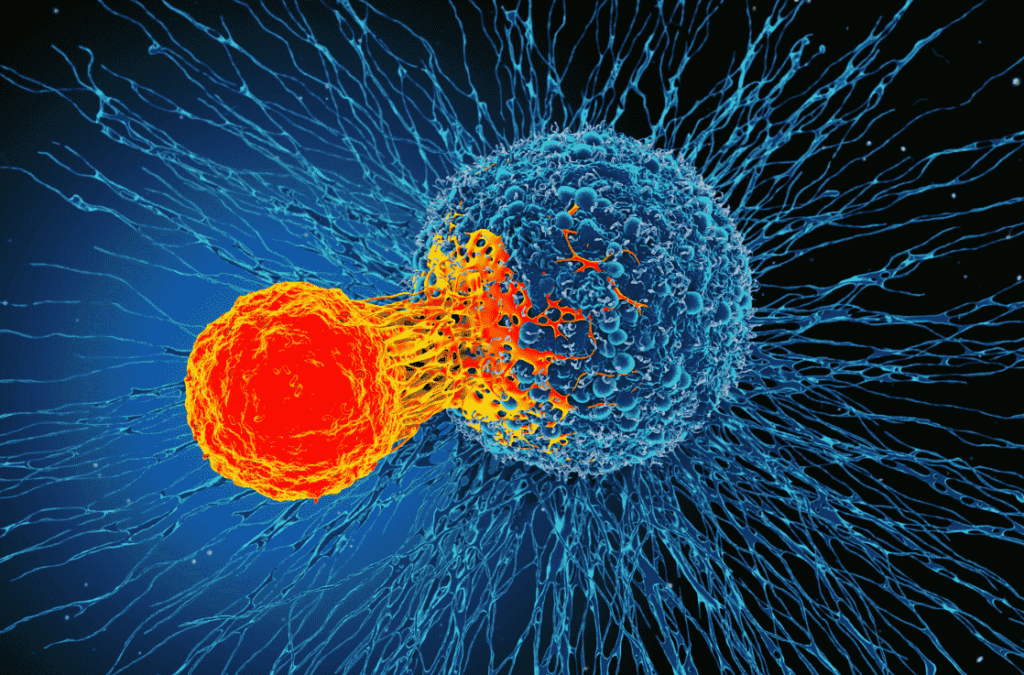
One sign of zinc deficiency is lymphopenia (or lymphocytopenia), which means a reduction in the total number of lymphocytes. When zinc deficiency occurs, the number of T and B lymphocytes in the thymus and bone marrow decreases, resulting in an increased risk of infections and weakening of the body’s natural defenses 27.
For example, with regard to T lymphocytes, studies have shown that zinc deficiency causes a condition called thymic atrophy, which is a decrease in the size of this gland. Thymic atrophy reduces T-cell production and diversity, which can affect the immune response 28.
Ultimately, zinc deficiency decreases the body’s ability to fight pathogens 16, 29, leading to increased susceptibility to a variety of infectious agents 30. This is especially relevant for the elderly, who often have lower zinc absorption 31, due to, for example, problems in intestinal absorption, inadequate chewing of food, psychosocial factors, drug interactions and disease 32.
A dynamic approach to strengthening natural defenses
Undoubtedly, having a healthy diet that ensures adequate amounts of Vitamin C and Zinc is the essential starting point to protect us against the constant siege of pathogens in our body. However, in particular situations, supplementation may be necessary to ensure the supply of the minimum daily amounts of these nutrients or to obtain additional benefits by ingesting higher amounts than those usually obtained through the diet. Vitamin C clearly exemplifies this situation.
In this regard, Nutribiolite has developed a food supplement that provides a daily dose of 1000 mg of vitamin C, combined with 50 mg of highly bioavailable chelated zinc, providing 10 mg of elemental zinc (100% of the recommended daily intake for adults – NRV).
Vitamin C (1000 mg)
In addition to enjoying all the benefits of vitamin C mentioned throughout this blog , ingesting a daily dose of 1000 mg (1g) can bring additional benefits to your supplementation plan. Supplementation with 1000 mg of vitamin C has been shown to be associated with a rapid but transient increase in vitamin C concentrations in the fluids lining the airways 33, which may provide immediate antioxidant protection to lung tissues and temporarily attenuate oxidative stress in the airways.
According to a clinical investigation carried out in the United Kingdom in 2002, involving 168 adults, it was observed that daily supplementation of 1000 mg of vitamin C for 60 days was associated with a reduction in the duration of colds (1.8 vs. 3.1 days) 34.
The latest systematic review and meta-analysis of randomized controlled clinical studies, conducted by the Cochrane Foundation in 2013, reveals moderate beneficial effects of vitamin C supplementation in reducing the duration and severity of the common cold in the general population 35. The authors highlight the consistency of these effects in regular supplementation studies, supporting the idea that, given the affordability and safety of vitamin C, it may be valuable for individuals with the common cold to personally consider the therapeutic utility of this nutrient, despite the recommendation to conduct further studies to support these findings 35.
The review has even highlighted a significant benefit in individuals experiencing extreme physical stress, such as athletes and the military, where the need for the antioxidant action of vitamin C is crucial 35.
It is essential to note that regular intake of doses higher than 2000 mg per day may cause symptoms such as diarrhea, heartburn, vomiting and even contribute to the formation of kidney stones, so this practice is discouraged. If you have any doubts about the right amount of vitamin C for your particular situation, we recommend that you consult your doctor. It is also important to note that vitamin C supplements should not be considered as a substitute for a healthy, balanced diet.
It is important to note that regular intake of doses higher than 2000 mg per day may cause symptoms such as diarrhea, heartburn, vomiting and even contribute to the formation of kidney stones, so this practice is discouraged. If you have any doubts about the right amount of vitamin C for your particular situation, we recommend that you consult your doctor. It is also important to note that vitamin C supplements should not be considered as a substitute for a healthy, balanced diet.
Zinc in the form of Zinc Picolinate
Given the wide geographic distribution and significant prevalence of zinc deficiency, along with the consequent implications for immune function, ensuring a continuous and moderate intake of this trace element could provide remarkable benefits, thus contributing to the preservation of respiratory health 36.
In terms of supplementation, zinc chelates, such as zinc picolinate, have significant advantages over inorganic forms of zinc, such as zinc oxide or zinc sulfate, which are often found in lower quality supplements. These are chemical variants in which zinc is bound to an organic molecule, thus enhancing its absorption in the gastrointestinal tract. In addition, these zinc options are generally better tolerated and less likely to cause unpleasant side effects, such as the gastrointestinal problems associated with inorganic forms of zinc.
Various forms of zinc chelate are available in dietary supplements, the most common and approved for human consumption being zinc citrate, zinc gluconate and zinc picolinate. All of these forms of zinc are beneficial, but zinc picolinate stands out as having superior absorption 38.
What is zinc picolinate?
Zinc picolinate is a form of zinc in which one atom of zinc is bound to two molecules of picolinic acid. Picolinic acid is a substance produced naturally in our body from tryptophan. It plays a very important role in the absorption and retention of zinc in the body, as well as other trace elements such as copper, chromium or manganese 39. Its chelating capacity allows zinc and other minerals to be more easily absorbed in the intestine.
Superior bioavailability
In a clinical study, researchers determined zinc levels in different parts of the body (hair, red blood cells and urine) of participants who received zinc supplementation in the form of an organic chelate. The participants were divided into groups according to the form of chelate administered: zinc picolinate, zinc citrate or zinc gluconate, in addition to the placebo group (which received a tablet without zinc) 38. The researchers observed that the group that received zinc supplementation in the form of zinc picolinate had better absorption of zinc, which resulted in a significant increase in zinc levels after 4 weeks of supplementation.
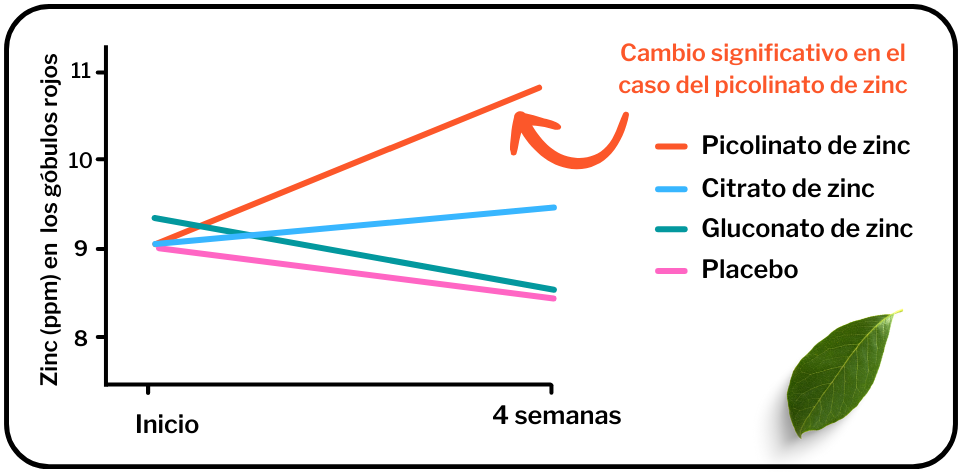
Why 50 mg of zinc picolinate?
Because zinc picolinate is well absorbed in the body 38, it is possible to use lower amounts of elemental zinc per dose, reducing the risk of intestinal problems and nausea that can occur with higher doses of zinc 40. In addition, with only 50 mg of zinc picolinate, we get 10 mg of elemental zinc, already meeting 100% of the recommended daily allowance for adults (NRV – nutrient reference values).
Another significant reason is that high concentrations of zinc can hinder the absorption of copper in the body. This is due to the affinity of metallothioneins, proteins crucial in the intracellular regulation of copper, to bind readily to zinc. This process can result in copper dysplasia, generating interferences in its absorption process.
Strengthened Natural Defenses: Immune Alliance of Vitamin C and Zinc
The effectiveness of the combination between vitamin C and zinc was demonstrated in a study published in 2012, which concluded that the joint supplementation of 1000 mg vitamin C and 10 mg elemental zinc was notably more effective than placebo in the recovery from infectious viral diseases, such as the common cold. For example, this combination was found to significantly reduce rhinorrhea and alleviate other cold symptoms in just 5 days of treatment 41.
In summary, Nutribiolite offers a complete solution to strengthen natural defenses with its food supplement that combines 1000 mg of vitamin C and 50 mg of highly bioavailable zinc picolinate. This balanced combination seeks to enhance immune function and promote overall health.
References
- Schectman, G., J.C. Byrd, and H.W. Gruchow, The influence of smoking on vitamin C status in adults. Gruchow, The influence of smoking on vitamin C status in adults. Am J Public Health, 1989. 79(2): p. 158-62.
- San Mauro-Martín, I. and E. Garicano-Vilar, Role of vitamin C and B-glucans on the immune system: a review. Spanish Journal of Human Nutrition and Dietetics, 2015. 19: p. 238-245.
- Jariwalla, R.J. and S. Harakeh, Antiviral and Immunomodulatory Activities of Ascorbic Acid, in Subcellular Biochemistry: Ascorbic Acid: Biochemistry and Biomedical Cell Biology, J.R. Harris, Editor. 1996, Springer US: Boston, MA. p. 215-231.
- Kennes, B., et al., Effect of vitamin C supplements on cell-mediated immunity in old people. Gerontology, 1983. 29(5): p. 305-10.
- Panush, R.S., et al., Modulation of certain immunologic responses by vitamin C. III. Potentiation of in vitro and in vivo lymphocyte responses. Int J Vitam Nutr Res Suppl, 1982. 23: p. 35-47.
- Prinz, W., et al., The effect of ascorbic acid supplementation on some parameters of the human immunological defence system. Int J Vitam Nutr Res, 1977. 47(3): p. 248-57.
- Vallance, S., Relationships between ascorbic acid and serum proteins of the immune system. Br Med J, 1977. 2(6084): p. 437-8.
- Anderson, R., et al., The effects of increasing weekly doses of ascorbate on certain cellular and humoral immune functions in normal volunteers. Am J Clin Nutr, 1980. 33(1): p. 71-6.
- Levy, R., et al., Vitamin C for the treatment of recurrent furunculosis in patients with imparied neutrophil functions. J Infect Dis, 1996. 173(6): p. 1502-5.
- Bergsten, P., et al., Millimolar concentrations of ascorbic acid in purified human mononuclear leukocytes. Depletion and reaccumulation. J Biol Chem, 1990. 265(5): p. 2584-7.
- Evans, R.M., L. Currie, and A. Campbell, The distribution of ascorbic acid between various cellular components of blood, in normal individuals, and its relation to the plasma concentration. British Journal of Nutrition, 1982. 47(3): p. 473-82.
- Jariwalla, R. and S. Harakeh, Mechanisms underlying the action of vitamin C in viral and immunodeficiency diseases. 1997. p. 309-322.
- Carr, A.C. and S. Maggini, Vitamin C and Immune Function. Nutrients, 2017. 9(11).
- Commission Regulation (EU) No 432/2012 of 16 May 2012 establishing a list of permitted health claims made on foods, other than those referring to the reduction of disease risk and to children’s development and health (Updating Regulation (EC) No 1924/2006). Official Journal of the European Union 2012.
- Olechnowicz, J., et al., Zinc status is associated with inflammation, oxidative stress, lipid, and glucose metabolism. The Journal of Physiological Sciences, 2018. 68(1): p. 19-31.
- Maares, M. and H. Haase, Zinc and immunity: An essential interrelation. Arch Biochem Biophys, 2016. 611: p. 58-65.
- Ugarte, M. and N.N. Osborne, Recent advances in the understanding of the role of zinc in ocular tissues. Metallomics, 2013. 6(2): p. 189-200.
- Zinc and the regulation of vitamin B6 metabolism. Nutr Rev, 1990. 48(6): p. 255-8.
- Kogan, S., A. Sood, and M.S. Garnick, Zinc and Wound Healing: A Review of Zinc Physiology and Clinical Applications. Wounds : a compendium of clinical research and practice, 2017. 29(4): p. 102-106.
- Prasad, A.S., et al., Zinc status and serum testosterone levels of healthy adults. Nutrition, 1996. 12(5): p. 344-8.
- MacDonald, R.S., The Role of Zinc in Growth and Cell Proliferation. The Journal of Nutrition, 2000. 130(5): p. 1500S-1508S.
- Beyersmann, D. and H. Haase, Functions of zinc in signaling, proliferation and differentiation of mammalian cells. Biometals, 2001. 14(3): p. 331-341.
- Gower-Winter, S.D. and C.W. Levenson, Zinc in the central nervous system: From molecules to behavior. Biofactors, 2012. 38(3): p. 186-93.
- Rubio, C., et al., Zinc: essential trace element. Hospital Nutrition, 2007. 22: p. 101-107.
- Terrin, G., et al., Zinc in Early Life: A Key Element in the Fetus and Preterm Neonate. Nutrients, 2015. 7(12): p. 10427-46.
- Russell, R.M., M.E. Cox, and N. Solomons, Zinc and the special senses. Ann Intern Med, 1983. 99(2): p. 227-39.
- Skrajnowska, D. and B. Bobrowska-Korczak, Role of Zinc in Immune System and Anti-Cancer Defense Mechanisms. Nutrients, 2019. 11(10).
- Luo, M., et al, Infection-Associated Thymic Atrophy. Frontiers in Immunology, 2021. 12.
- Subramanian Vignesh, K. and G.S. Deepe, Jr, Immunological orchestration of zinc homeostasis: The battle between host mechanisms and pathogen defenses. Arch Biochem Biophys, 2016. 611: p. 66-78.
- Fischer Walker, C. and R.E. Black, Zinc and the risk for infectious disease. Annu Rev Nutr, 2004. 24: p. 255-75.
- Cabrera Á, J., Zinc, aging, and immunosenescence: an overview. Pathobiol Aging Age Relat Dis, 2015. 5: p. 25592.
- Maares, M. and H. Haase, A Guide to Human Zinc Absorption: General Overview and Recent Advances of In Vitro Intestinal Models. Nutrients, 2020. 12(3).
- Behndig, A.F., et al., Augmentation of respiratory tract lining fluid ascorbate concentrations through supplementation with vitamin C. Inhal Toxicol, 2009. 21(3): p. 250-8.
- Van Straten, M. and P. Josling, Preventing the common cold with a vitamin C supplement: a double-blind, placebo-controlled survey. Adv Ther, 2002. 19(3): p. 151-9.
- Hemilä, H. and E. Chalker, Vitamin C for preventing and treating the common cold. Cochrane Database of Systematic Reviews, 2013(1).
- Wintergerst, E.S., S. Maggini, and D.H. Hornig, Immune-enhancing role of vitamin C and zinc and effect on clinical conditions. Ann Nutr Metab, 2006. 50(2): p. 85-94.
- Singh, M. and R.R. Das, Zinc for the common cold. Cochrane Database of Systematic Reviews, 2011(2).
- Barrie, S.A., et al., Comparative absorption of zinc picolinate, zinc citrate and zinc gluconate in humans. Agents and Actions, 1987. 21(1-2): p. 223-8.
- Birdsall, T., Zinc picolinate: Absorption and supplementation. Alternative Medicine Review, 1996. 1: p. 26-30.
- Samman, S. and D.C. Roberts, The effect of zinc supplements on plasma zinc and copper levels and the reported symptoms in healthy volunteers. Med J Aust, 1987. 146(5): p. 246-9.
- Maggini, S., S. Beveridge, and M. Suter, A Combination of High-Dose Vitamin C plus Zinc for the Common Cold. Journal of International Medical Research, 2012. 40(1): p. 28-42.

